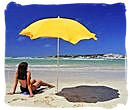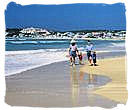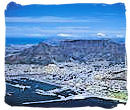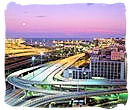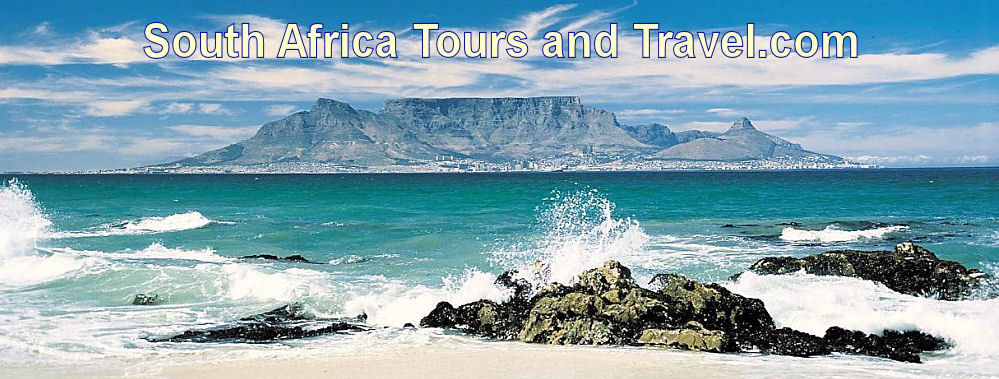 |
|||||||||||||
The Augrabies Falls National Park, place of great noiseThe Augrabies Falls National Park is to be found in the barren and desolate landscape of sand scrub and rock of the green Kalahari region in the north of the Northern Cape Province, where the Orange river flows wide and slowly, traversing sandy soils.
About 120km west of Uppington, it changes into a fast flowing river cutting its way through ancient granite soil. Then, in an ultimate demonstration of its awesome power, the mighty Orange river thunders down a 56 meters sheer rock wall at first and then in a spectacular misty tumble of cataracts into a turbulent, rock-enclosed pool 240 meters below. From here the powerful waters have cut their way deep into the granite soil, forming the famous Orange River Gorge with an average depth of 240 meters. The Nama people (descendents from the original Khoi inhabitants) have lived in the region for centuries. They aptly called the waterfall "Akoerebis", meaning "Place of Great Noise", from which the current name “Augrabies Falls” has been derived. Augrabies falls are the second largest waterfalls in africa, with theVictoria waterfall being the largest. Learn more about the Park by clicking on any of the items in the menu below;
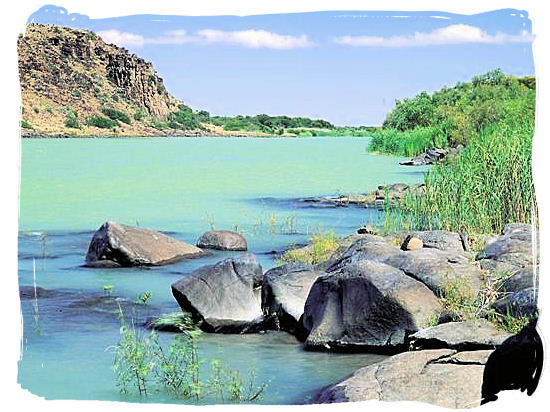 The mighty Orange river flowing wide and slowly below the Vanderkloof Dam copyright © South African tourism General info,... 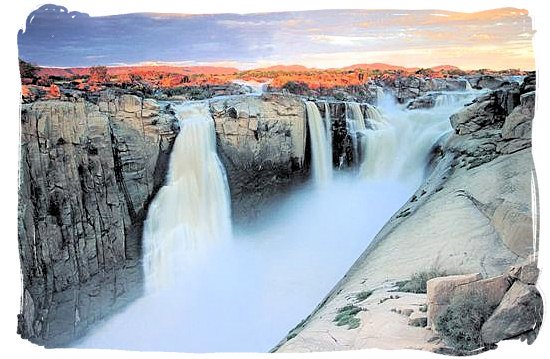 The spectacular Augrabies Falls copyright © South African tourism In order to conserve the ecosystem of the Orange River broken veld region and to maintain the Augrabies waterfall and its surroundings in an unspoiled state, the Augrabies Falls National Park was proclaimed on 5 August 1966. The Park currently consists of 55.383 hectares. It is situated in the Green Kalahari region about 40km northwest of the town of Kakamas and 120km west of Uppington, bordering on Namibia at its north-western side. The area is inhabited by the Nama people (descendents of the Khoi-Khoi) who over the centuries have managed to adapt to the harsh conditions of the area. 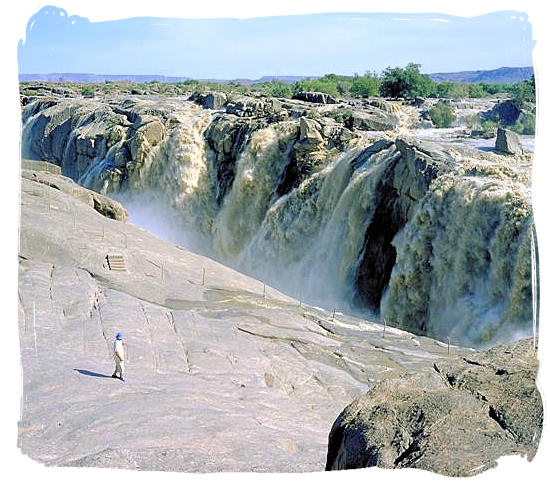 The Augrabies Falls, second largest in Africa after the Victoria falls copyright © South African tourism The quantity of water flowing over the falls varies greatly. The normal and average water flow is around 50.000 litres per second, enough to hear the rumbling of the water all over the rest camp and beyond. The water flow is the highest between November and April when most of the rain falls. At times it has been as high as 1.900.000 litres per second. In times of extreme drought however the water flow has been known to diminish to a mere trickle. Nowadays the water level rarely drops below the average 50.000 litres per second because of the dams that have been placed further upstream. 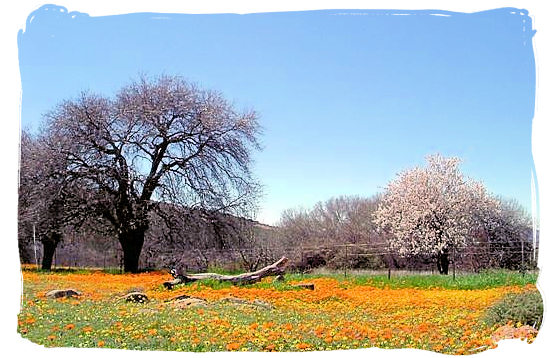 Flowering desert after some good rains near the town of Kakamas, 40km from Augrabies copyright © South African tourism The vegetation in the National Park is typical of the surrounding southern Kalahari region. It includes the giant Aloe "Aloe dichotoma", better known as the Quiver Tree or Kokerboom in "Afrikaans" and numerous other Aloe species, several varieties of "Vygies" or Mesembryanthemums and shrubs such as Raisin bush and Cat-horn. The main tree species in the Park are Camel-thorn, White Karee and Wild Olive. The Quiver Tree which grows three to five meters high, derived its name from the ancient custom of the "San" people of hollowing out the soft branches of the tree to make quivers (kokers) in which to keep their arrows. 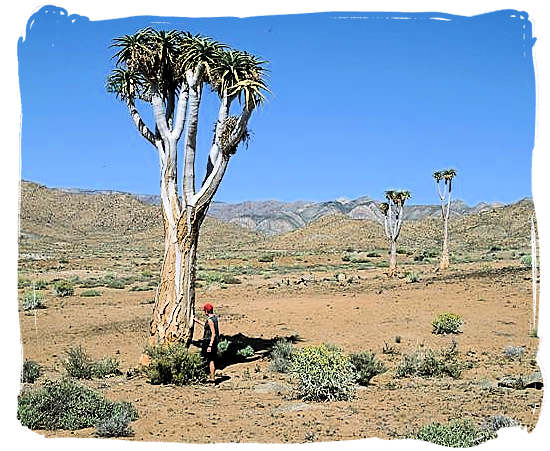 The Giant Quiver Tree, “Aloe dichotoma” copyright © South African tourism In the stark beauty of the harsh and rocky environment of the Augrabies Falls National Park only the fittest survive. Over 55 species of mammals and 63 species of reptiles may be seen in the park. The Quiver Trees share the fairly inhospitable terrain with dainty Klipspringers, reptiles, fleet-footed Springboks and the majestic Gemsbok. One of the antelope species quite often seen is the rare Klipspringer. Other antelope species to be found in the Park are Steenbok, Kudu and Eland. Predators that can be found in Augrabies National park are Leopard, Black backed Jackals, Caracal, the Bat eared Fox, and the African wild cat. 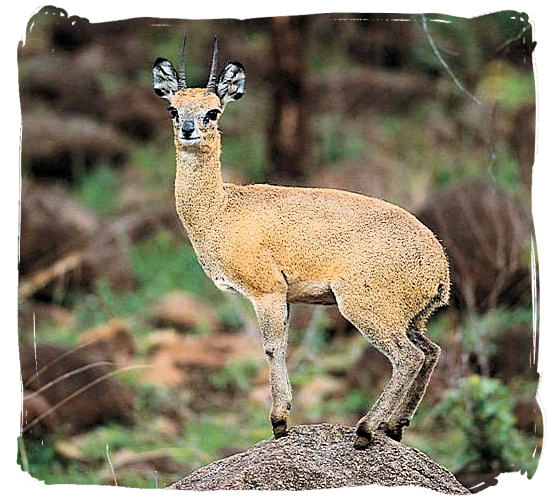 The rare Klipspringer, one of the smallest of the antelope species. copyright © South African tourism Extreme temperature fluctuations in the region have resulted in unique adaptations of animals. The animals in the Park can survive in extreme high and low temperatures. Smaller animals make use of whatever shade is available as well as burrows, rock crevices and fallen trees. The types of animals that have made these adaptations are the Slender Mongoose, the Yellow Mongoose, and Rock Dassies. The Giraffes found in Augrabies are lighter in colour than those found in the regions of the east, as a counter measure for the extreme heat. 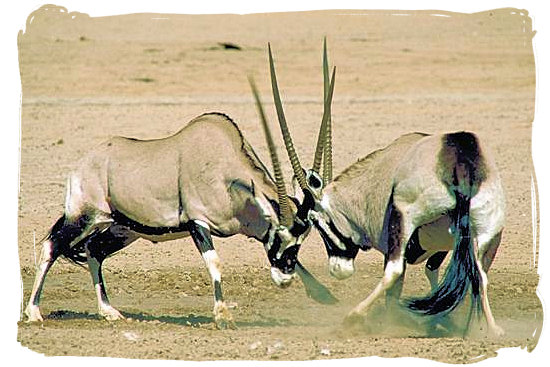 Two Gemsbok antelopes (“Oryx Gazella”) having a go at each other copyright © South African tourism Bird watching is a popular activity in the park and the camp area is a good place to start, with Rosy-faced Lovebird, Golden-tailed Woodpecker, Acacia Pied Barbet, Ashy Tit, African Red-eyed Bulbul, Namaqua Warbler, Black-chested Prinia, Pririt Batis, Pale-winged Starling, Dusky Sunbird and the beautiful Orange River White-eye. All of them are to be found in the acacia bush and riverine vegetation. The Cinnamon-breasted Warbler, Short-toed Rock-Thrush and Mountain Wheatear occur on the rocky “koppies” found on the drives. A good spot to try for Cinnamon-breasted Warbler is Echo Corner. 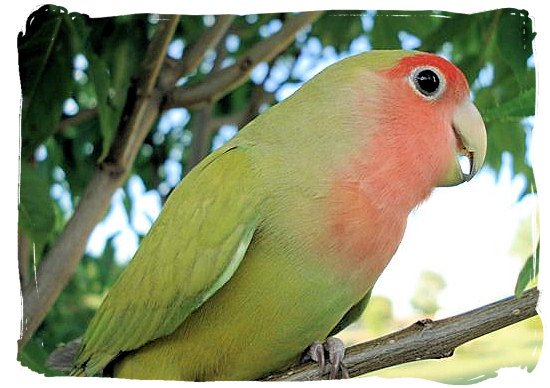 The Augrabies Falls National Park, is part of the natural habitat of the well known Rosy-faced Lovebird ("Agapornis Roseicollis") The Orange river gorge just below the camp, in which the orange river forms the actual Augrabies Falls, supports breeding Black Stork, Verreaux's Eagle and Peregrine Falcon, as well as huge mixed flocks of aerial feeders such as Alpine Swift, African Black Swift, Brown-throated Martin and Rock Martin. Other typical Karoo species occurring in the open arid country away from the river include Ludwig's Bustard, Double-banded Courser, Stark's Lark, Spike-heeled Lark, Karoo Long-billed Lark, Grey-backed Sparrow Lark, Black-eared Sparrow Lark, Rufous-eared Warbler and Chat Flycatcher. 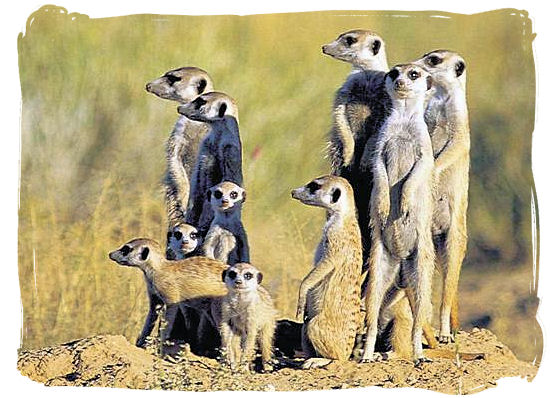 Mongoose family, divided attention copyright © South African tourism <<< Top of Page Accommodation,... Augrabies Falls National Park offers a selection of luxury cottages and bungalows with fully equipped kitchens, to suit your preferences. Caravan and camping sites with excellent communal kitchen and ablution facilities are located in areas with plenty of shade. 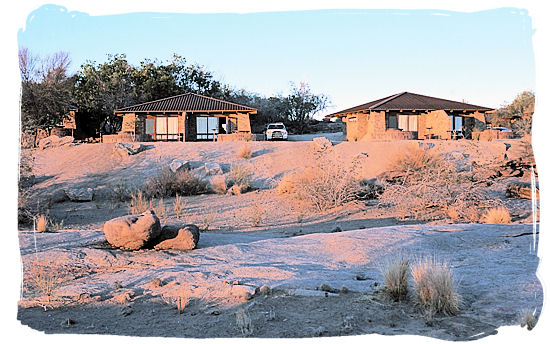 Chalets in the Augrabies Falls National Park copyright © SANparks The variety of accommodation includes the following;
Facilities,... Day visitors are welcome to the park and facilities, such as a picnic area, are available. Cottages, bungalows and camping sites are all equipped with electricity. Medical and car repair facilities are available at the town of Kakamas, about 40km away. 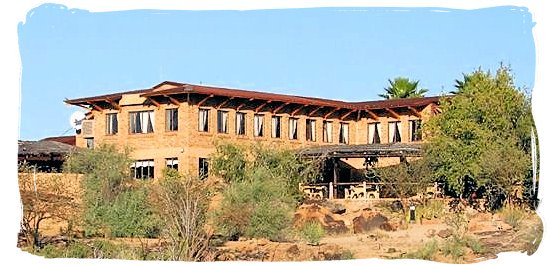 Reception offices and Restaurants at Augrabies Falls National Park B>Facilities at the Augrabies Falls National Park include the following;
Two of the bungalows in the rest camp are accessible to wheelchairs (ramped entrance, sit-down shower). The reception complex, shop, tea area and information displays have been made accessible to wheelchairs. However, the restaurant is upstairs. The route to the falls covers some very rough terrain and wheelchair users will need assistance. None of the other viewpoints are wheelchair accessible. <<< Top of Page Climate,... 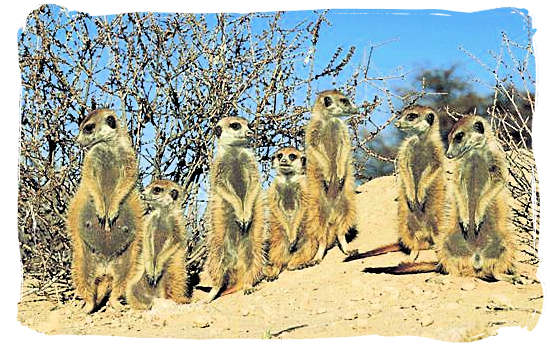 Mongoose family, well adapted to the blazing desert heat copyright © South African tourism The summers are very hot in the Park. Temperatures are generally 30°C or higher. The warmest months are December, January and February, with temperature peeks exceeding the 40°C mark. The winters on the contrary can be quite cold and frosty at night, with average day temperatures of 18°C. The coldest months are June and July with temperatures dropping well below zero during the nights. Rainfall is erratic and can be as high as 400mm per year, but also as low as 40mm per year (July to June). The average annual rainfall of 211mm, which mainly falls during the summer period January to April. <<< Top of Page Accommodation availability,... 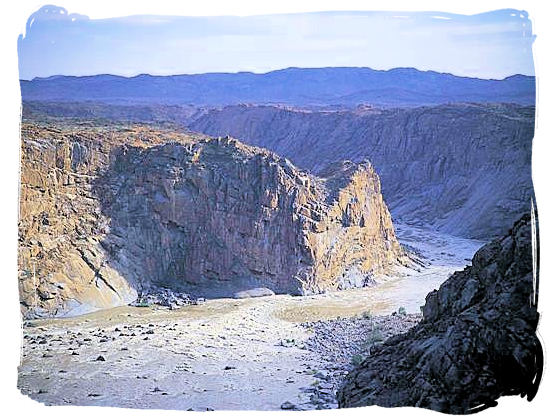 The Orange river gorge below the Augrabies Falls copyright © South African tourism Go to SANParks.org to view the Accommodation availability page of the South African National Parks organization’s (SANparks) website, showing a monthly calendar with accommodation availability details for the Park.
Tariffs,... 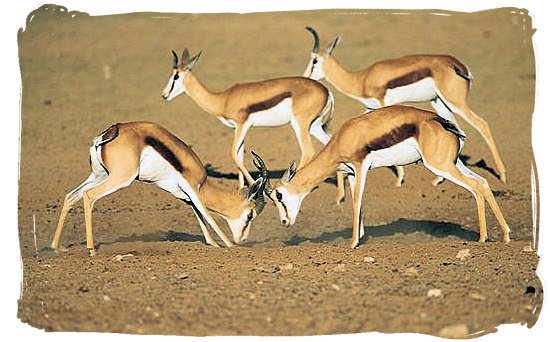 The springbok antelope, one of South Africa's national symbols copyright © South African tourism Go to SANParks.org to view the tariffs applicable for the Augrabies Falls National Park on the official tariff page of the South African National Parks (SANparks) website. <<< Top of Page Reservations,... 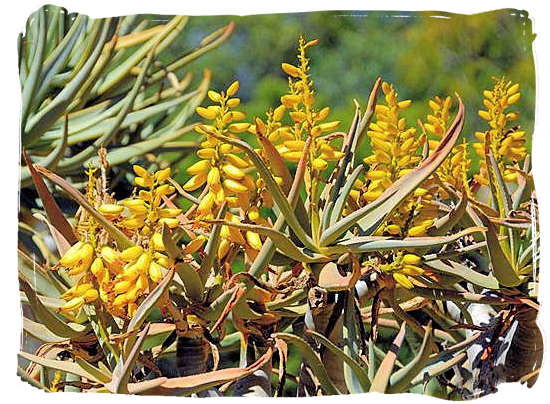 Flowering Quiver tree Photograph by Martin Heiman Go to SANParks.org to book your reservation for the Augrabies Falls National Park on the official reservations page of the South African National Parks organization's (SANparks) website. <<< Top of Page How to get there,... 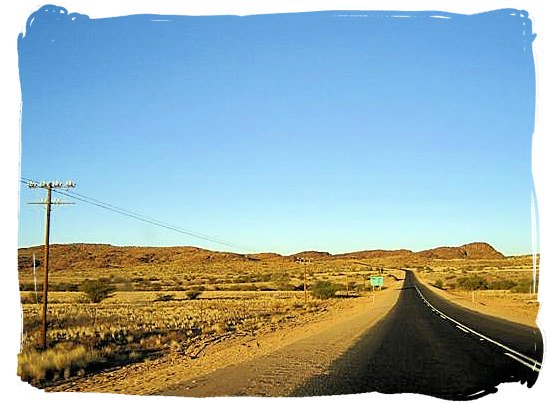 Early morning on the road to the Augrabies Falls National Park Photograph by Emma Carpenter BY AIR: The nearest domestic airport is at the town of Uppington, 120km to the east of the Augrabies Falls National Park, with air links to and from the international airports of Johannesburg and Cape Town. A number of car hire agencies have depots at the airport. The drive to Augrabies will take you about an hour and a half. There is also a private airfield about 5km from the park, suitable for light aircraft only. BY ROAD: The distance by road between Johannesburg and the Park is 902km, which should take you about 11 hours. From Cape Town to Augrabies is a distance of 796km, about a 10 hours drive. <<< Top of Page Video,... The waterfall can be viewed from viewpoints that are within walking distance from the restaurant complex. The video shows you the Augrabies Falls in full flow and also some of the walkways taking you to the lookout platforms and other viewing points. All of the park's top geographical attractions are located just a short distance (by car) from the rest camp area. The farthest, Echo Corner, is about 14km from the rest camp, with all the other sights (Moon Rock, Ararat and Oranjekom) in between. If you're really pressed for time the best thing to do is drive to Moon Rock and climb to the top of it for a stunning view. Top of Page |
|
||||||||||||
|
|
|||||||||||||
